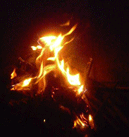The Third Exhibition of New Art at Tehran University
The third exhibition of New Art will be held at Tehran University. This project will be online at the following address: www.iraniannewart.com

40 Days Travel: Works by Nadalian In Italy & Germany (2003)
In June 2003, when Nadalian presented his RiverArt project in the 50 biennale of Venice, he carved images of fish on the stones and rocks of seashore in Lido. He also dropped many of his stones with images of fish in the Canal of Venice. This was done with the hope of bringing better environment, life and fertility. Then he has been invited for the exhibition of Open 2003. In August 2003 he went back to Italy and carved more fish, crabs, snakes, hand and feet on the stones and rocks of Lido as a part of the Open 2003 exhibition.

In September 2003 he went to Germany and studied German at Goethe Institute in Mannheim. There he participated in some exhibitions and left a set of carvings at Rhein River.
Between 6th, 7th and 8th of September, he participated in the Exhibition of What is Art? What is Sound? in Luisen Park of Mannheim.
In Luisen Park he set up some environmental installation. He also left many of his carving in the parks and the stream which passing through the Park.
Between 12 to 22 September 2003, he exhibited his works and set up a water installation in the Goethe Institute. This exhibition was held in the occasion of International day of Goethe. He also carve three peace of stones and dedicated them to Goethe Institute.

When he lived in Mannheim, he carve many images on the stones of Rhein River (Strandbad & Sillerpappel in Wald Park) in Mannheim. This series, which he has named “The Rhein again has Fish”, have been abandoned at the site where they were created.
Works In Lido (Italy)
Works In Venice (Italy)
Works In Germany
Works in Luisen Park
Works in Goethe Institute
Works at Rhein River
Sixth Biennale of Iranian Contemporary Painting: Selected Artists

More:
The First Festival Celebrating the Creation and Exhibition of Art in Nature
The first festival celebrating the creation and exhibition of art in nature was held at Paradise International Art Center. Our subject was the four elements: Water, Earth, Wind and Fire. More

The Death of Fish: The River No Longer Has any Fish
The story began when a painter returned to his homeland after years of living abroad, having finished his studies and received a doctorate degree, and was in search of his lost paradise. He had returned to the land of his forefathers, seeking a peaceful life, far away from the troubles of the city. Although he was now a city person, he missed a great many things. He wished to spend time surrounded by nature, living with nature. The hills and valleys near Mount Damavand on the outskirts of Poloor village held many childhood memories. It was not just family memories that bound him to the region; in his eyes, Mount Damavand personified the entire history of Iran’s mythology and culture: the infinite tales of creation, the simorgh, the dragon, Fereydoun and Zahhak… Upon his return to the land of his forefathers, he found that his paradise no longer existed. The wellspring was polluted and the river no longer had fish. He wanted to build his own paradise. He began playing with the water, and the water played with him. He created hundreds of fish on the stones of the river. He was happy that his early memories existed, if only as fossilized remnants. He liked to believe that these fish are alive, and were swimming against the tides. The darkest moments were when he witnessed the death of the fish. He saw his fish buried time and again. This village does not have a leader. The rivers are sown and the meadows are planted with villas. Factories are constructed on riverbeds and roads are built… But he is not tired. He is determined as ever to build his paradise. He has taken refuge in the deep ravines. There is no sign of either Zahhak or machine here. There is a temple, where one is at peace to worship water. His most beautiful moments were when he sat watching the turbulent water of the river, and the frolic of his imaginary fish; the most meaningful occurrence was the gradual disappearance of the images. He learned that images disappear, but life remains; forms disappear, but meaning remains.
|










